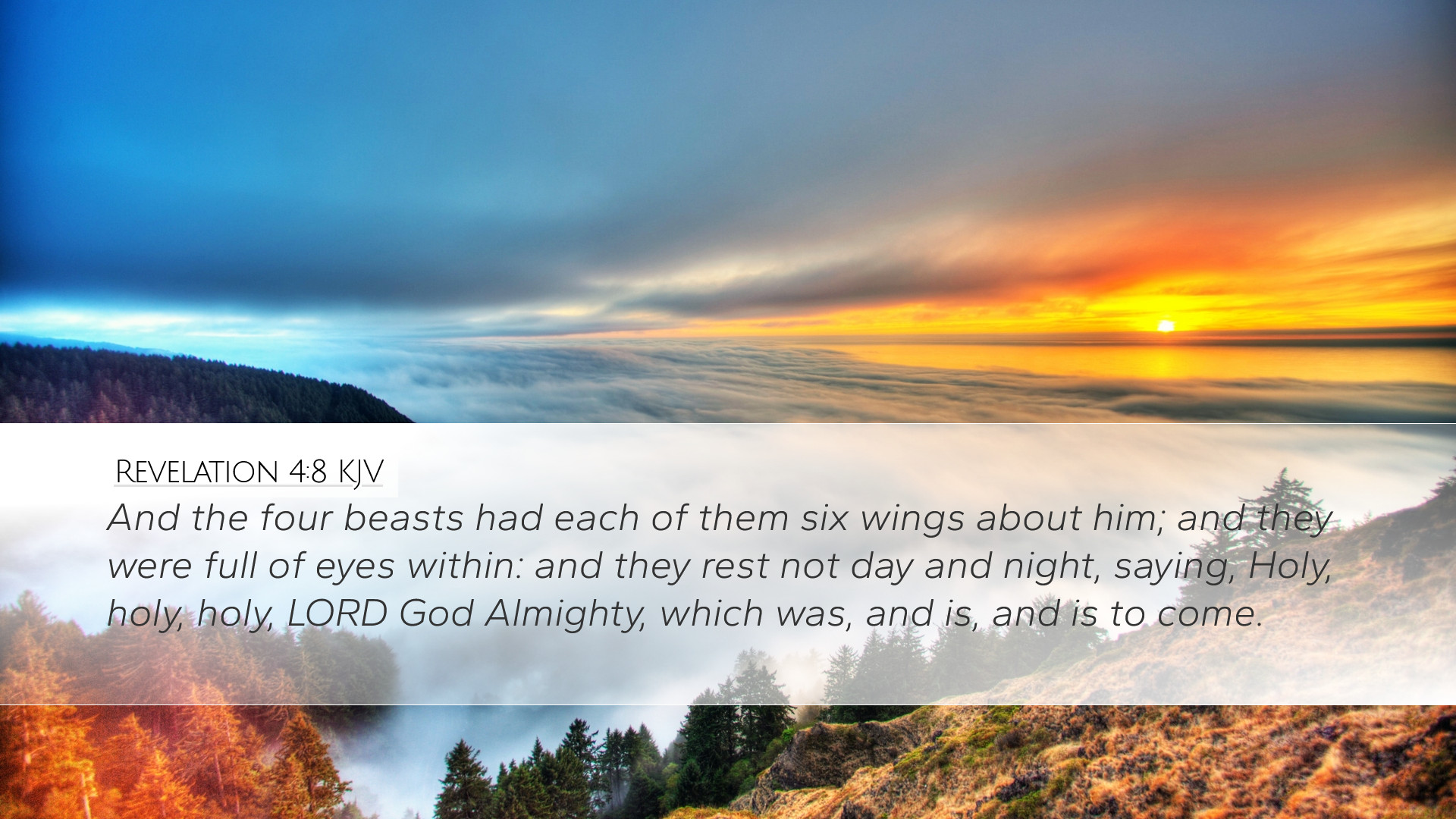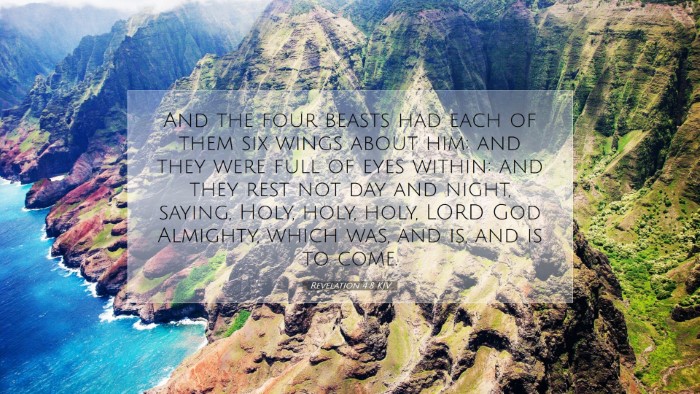Commentary on Revelation 4:8
Verse: "And the four beasts had each of them six wings about him; and they were full of eyes within: and they rest not day and night, saying, Holy, holy, holy, Lord God Almighty, which was, and is, and is to come."
Introduction
The vision described in Revelation 4:8 provides a stunning introduction to the celestial scene surrounding the throne of God. This verse emphasizes both the majesty of God and the worship that surrounds Him. The beings mentioned in this verse, often referred to as the "four living creatures," play a significant role in the heavenly liturgy and reveal deep theological truths about the nature of God and the worship due to Him.
The Four Living Creatures
-
Description: The four beasts, or living creatures, are depicted as having six wings and being full of eyes. This imagery is rich with meaning. The wings symbolize their readiness to serve and their swift movement in the execution of God’s will, while the eyes suggest a complete and penetrating perception of truth and reality.
-
Symbolism: Matthew Henry points to the symbolic nature of these beings, interpreting their appearance as reflective of the attributes of God’s creation—strength, wisdom, and swiftness—exemplified by their various forms resembling a lion, a calf, a man, and an eagle (as mentioned in previous verses). This diversity in forms can be understood to represent the entirety of God’s creation praising Him.
The Constant Worship
The phrase "and they rest not day and night" strongly indicates that the worship of God is eternal and unceasing. Albert Barnes elaborates on this point, noting how worship in heaven is not akin to the fatigue experienced on earth; instead, it reflects the supreme joy and fulfillment found in praising God. In this unending worship, the creatures serve as a model for believers, encouraging a life that continually acknowledges God's holiness.
The Holiness of God
The repeated declaration "Holy, holy, holy" underscores the absolute holiness of God. Adam Clarke emphasizes that the triad of 'holy' is not only a heightening of the attribute but also a reflection of the complete and perfect nature of God's holiness. In ancient Jewish culture, repetition served to indicate emphasis and importance, and here it articulates an essential truth about who God is. His holiness sets the standard for moral purity and righteousness, and this acknowledgment is central to both angelic and human worship.
The Title: Lord God Almighty
The title "Lord God Almighty" encapsulates key theological concepts. The term "Lord" indicates authority and sovereignty, while "God" signifies divinity. "Almighty" conveys omnipotence—God's unrivaled power over all creation. Together, these elements form a robust understanding of God's nature that invites reverence and awe. Matthew Henry notes that the acknowledgment of God’s power in creation inspires those who worship Him within the heavenly assembly.
The Eternal Nature of God
The phrase "which was, and is, and is to come" highlights the eternal nature of God. This declaration not only extends into the past, present, and future but also affirms God's unchanging nature in all aspects of existence. It serves as a source of comfort and assurance for believers, affirming that despite temporal changes, God remains steadfast. Albert Barnes reflects on the comfort this eternal aspect of God provides amidst the struggles of life, serving as a reminder of divine sovereignty over history.
The Application for Believers
-
Worship: The unceasing worship of the four living creatures serves as an example for all believers. It challenges individuals to cultivate a lifestyle of worship that acknowledges God’s holiness and majesty, inspiring personal holiness and devotion in everyday life.
-
Perspective: Understanding the eternal nature of God shapes how believers view their own circumstances. They are called to trust in God’s sovereignty, aligning their lives with His will, as they recognize His overarching plan throughout history.
-
Holiness: The emphasis on holiness in this passage invites believers to strive for personal holiness, recognizing that they are called to reflect the character of God in their lives. Adam Clarke highlights that true worship cannot be separated from a life lived in obedience and purity before God.
Conclusion
Revelation 4:8 provides a profound insight into the worship of God and the character of the heavenly beings who serve Him. By recognizing His holiness, power, and eternal nature, believers are encouraged to deepen their faith, cultivate an attitude of worship, and embrace their calling to live out God's holiness in a world that desperately needs it. The vision granted to John not only calls for worship from the heavenly realms but also reflects a universal invitation for creation to join in this eternal chorus, proclaiming the majesty of the Almighty God.


